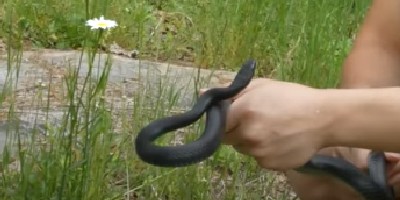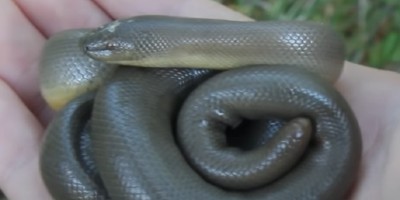
California Mountain King Snake
Latin name: Lampropeltis zonata
Size: 24 to 30 inches
Venomous: No
This snake species might look venomous, but the California mountain king snake is not harmful to humans, with no venom and rarely showing aggression. Mimicking the bands of the venomous coral snake is a defense mechanism for this snake, and it is a tactic that many other non-venomous snake species take on. Just look at the pattern of red, black, and white/yellow bands — if the red and yellow ones touch each other, it is a venomous coral snake. If black bands separate the red and yellow, it is not.
Northern Copperhead
Latin name: Agkistrodon contortrix mokasen
Size: 25 to 40 inches
Venomous: Yes
The northern copperhead is known by a host of other names, including eastern copperhead, highland moccasin, white oak snake, deaf snake, harlequin snake, and many more. A rather lazy and non-aggressive snake, it is venomous, but is thought to have the lowest-strength venom of all pit vipers found in North America. They are more of a fleeing snake than a fighting one, and they have a range of defense mechanisms that they would much rather use. Initial bites are even usually devoid of venom, with some experts referring to them as warning shots.
Puget Sound Garter Snake
Latin name: Thamnophis sirtalis pickeringii
Size: 22 to 54 inches
Venomous: No
As the name suggests, this subspecies of garter snake is usually found in and around the Puget Sound area of Washington. With dusky-blue stripes along a dark, usually black backdrop, this is a snake that really stands out, especially when it is matched with small red-orange spots or bands (occasionally). The underside is also a blue-turquoise color.
This snake is more active during the day — during the late afternoon when the temperatures are down, and in the early morning and late afternoon when the weather is hot.
Valley Garter Snake
Latin name: Thamnophis sirtalis fitchi
Size: 22 to 54 inches
Venomous: No
The valley garter snake is just one subspecies of garter snake found in Washington, and differs from others by having brighter, bolder patches of red on the sides of the body. The stripes that run along the back are also thicker, and the underside of the snake is orange-red-yellow, usually more red in tone.
Garter snakes are usually non-aggressive snakes, although they will put on a bit of a show when threatened or cornered. It is more probable that the snake will flee when it senses close human activity.
wester
Northn Garter Snake
Latin name: Thamnophis ordinoides
Size: 12 to 38 inches
Venomous: No
There are different species of garter snakes found in the state of Washington, with many subspecies within them, but the northwestern garter snake is the smallest of all of them. The body of this species can be a number of different colours, often being dependent on the territory around them, including dark black, brown, gray, or a mix of all three. There are three stripes that run along the top of the back, plus on each side, and these are a variety of colours, ranging from blue to white, yellow to orange, red to gray.
Terrestrial Garter Snake
Latin name: Thamnophis elegans vagrans
Size: 18 to 42 inches
Venomous: No
Of the three different species (and multiple subspecies) of garter snake found in the state of Washington, this one is the thickest of them. Also known as the wandering garter snake, the terrestrial garter snake eats a wide variety of prey items — other snakes, birds, bird eggs, snails, earthworms and other worms, slugs, frogs and tadpoles, leeches, rodents, and even fish. It is adaptable, changing up its diet to suit the habitat it’s in — from coniferous forests and grasslands to wetlands, in some cases.
Pacific Gopher Snake
Latin name: Pituophis catenifer
Size: 48 to 66 inches
Venomous: No
The Pacific gopher snake is a very adaptable snake, capable of living in quite the array of different habitats. As well as agricultural land, this snake can easily survive and thrive in woodlands and forests, brush-lands, deserts, and dry prairies.
The top of this snake's body is usually a pale color - cream, gray, or dirty white, with haphazard blotches across it, often dark brown, red-brown, or black. The underside of the snake is lighter and is often patterned with small black dots towards the edges.
Night Snake
Latin name: Hypsiglena torquata
Size: 10 to 25 inches
Venomous: (Yes, but it doesn't affect humans)
This snake is a venomous one, but the venom poses no threat to humans; it is very mild. The night snake can be creamy-beige, pale brown, or light grey in color, with uneven, darker spots that run the length of the sides. The underside is paler, often a creamy-yellow color.
This snake species is quite spaced out across Mexico and the southern states, but it is thought that populations in each area are quite low in numbers. It seems to survive well in lowlands as well as mountainous regions above 8,000 feet. Both sandy and rocky habitats have been reported, as well as mountain meadows, woodlands, thorny forests, grasslands, and desert regions.
Northern Desert Night Snake
Latin name: Hypsiglena chlorophaea deserticola
Size: 10 to 15 inches (Up to 25 inches)
Venomous: (Yes, but it doesn't affect humans)
Night snakes, and particularly the northern desert subspecies, is often confused with bull snakes (also known as gopher snakes), but can be told apart by looking at the pupils. In bull snakes, the pupils are circular in shape. Night snakes, however, have vertical, typically snake-shaped pupils.
The location of this snake usually plays an important role in the markings and colourations, which can range from a light tan or gray to deep, rich brown or almost black shades. The underbelly is lighter in color — a creamy-white, and there is usually a darker band of color around the neck area, along with a darker stripe that runs either around or behind the eyes.
Blue Racer
Latin name: Coluber constrictor foxii
Size: 35 to 75 inches
Venomous: No
Just as the name would imply, the blue racer, also commonly referred to as eastern racer, is a non-venomous, long and slender, narrow-headed snake that usually appears blue or blue-black in color. The underside is pale in contrast, white, cream, or yellow in color. As adults, this snake eats other snakes, turtles, squirrels, rabbits, birds, bird eggs, and many other mammals. Juveniles tend to opt for smaller critters, such as mice and rats, insects, and small snakes and other reptiles.
One of the biggest predators of this snake is humans, particularly in areas where pesticide use is high. The loss of prey and habitats has made populations decline.
 Western Racer
Western Racer
Latin name: Coluber constrictor mormon
Size: 35 to 75 inches
Venomous: No
Despite what the name suggests, the western racer can actually only travel at maximum speeds of 4mph, which is fast … but not as fast as you'd think. Also known as the western yellow-bellied racer or western racer, it is slender, long, and can be a range of blue, green or brown colours on top, with a yellow belly — as the nicknames would imply.
Western racers, and other racers, enjoy two types of habitat: lake edges, bogs, marshes and other similar bodies of water; and open fields, hedgerows, and woodlands, where it is dry, sunny, and perfect for basking.
Northern Pacific Rattlesnake
Latin name: Crotalus oreganus oreganus
Size: 15 to 48 inches
Venomous: Yes
Although this venomous snake can grow up to 48 inches, it generally grows to a maximum of around 36 inches, and the body is thick and heavy, with keeled scales. The head is triangular in shape, typical with the viper family, and the neck is thin compared to the head and the rest of the body.
With the rattle at the end of its tail, the northern Pacific rattlesnake can sometimes be found west of the cascades into Washington, trying to chase and capture various small animals, including rats and mice, squirrels, hares, rabbits, other snakes, lizards, birds, frogs and toads, and insects.
Northwestern Ring-Necked Snake
Latin name: Diadophis punctatus occidentalis
Size: 10 to 15 inches
Venomous: No
Although there are a few specimens that do not have the ring around the name, the northwestern ring-necked snake usually does, in bright orange or yellow, that is usually close to the color of the underbelly, which is red, orange, or yellow again. The main body of the snake is black or dark gray, getting darker towards the head, so these colours really stand out.
Primarily eating earthworms, salamanders and other soft-bodied insects, ring-neck snakes will also feed on other snakes, lizards and amphibians that they find in territories with high tree density, such as woodlands and forests.
 Northern Rubber Boa
Northern Rubber Boa
Latin name: Charina bottae
Size: 15 to 25 inches
Venomous: No
Most people think of quite big snakes when they think of boas, but the northern rubber boa is quite a small one, with a short and wide body, usually one dark color all over. Juvenile boas are much lighter and can even come with various colorings, and there can sometimes be a patchy or mottled effect on the underbelly of both adults and juveniles.
This snake is mostly nocturnal, but does occasionally come out during the day when necessity (hunger) calls for it. As well as other snakes, rubber boas eat rodents and other small mammals, frogs, lizards, and salamanders. This is a snake that can also live in mountain regions just as easily as it can in low grasslands.
Sharp-Tailed Snake
Latin name: Contia tenuis
Size: 12 to 18 inches
Venomous: No
This small snake is known by a string of other names in Washington, including the Pacific ground snake, Oregon worm snake, gentle brown snake, and more. It has a sharp-looking tail, as you'd imagine from the name, but this doesn’t actually do harm to humans or other prey items. Instead, experts believe the spine-tip is used to keep prey items in place so that they are easier for the snake to consume. It eats just slugs and their eggs (and the occasional small salamander), which are quite slippery items.
Striped Whip Snake
Latin name: Masticophis taeniatus
Size: 36 to 72 inches
Venomous: No
With a white or cream-colored underside and dark brown or black top adorned with stripes, the striped whip snake is mixed up with ribbon snakes and some garter snakes a lot, but this one tends to be a bit larger than the rest. This snake species inhabits a variety of territories in the state of Washington, such as pine and oak forests, other woodlands, grasslands, and canyons. It feeds on lizards, other snakes (including venomous snakes), birds, various insects, and small mammals.
This snake is known to be quite aggressive when threatened or provoked. It isn't a venomous snake, but the bites can still be quite painful.